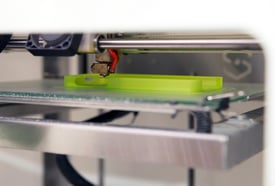3D Printing sounds complex, but it’s actually pretty simple once you get the hang of it. And when it comes to the world of injection molding, this new technology is turning out to have a pretty huge impact.
Essentially, instead of printing pages of paper with black ink or colored ink, as an inkjet printer will do, a 3D printer takes a digital file and creates a 3D solid object. This is also known as additive manufacturing. You may be wondering how this works and why it is so important. Here are 6 facts about 3D printing.
- The 3D Printing process begins with a virtual design of your desired object made in a CAD (Computer Aided Design) file, which can be done using a 3D modeling program to create a completely new object. You can also copy an existing object using a 3D scanner. If you use a 3D scanner, it will make a 3D digital copy of an object, just as a copier will copy a piece of paper.
- Prices of 3D scanners differ from extremely expensive professional industrial devices to DIY devices for home and personal use.
- Since 2010, 3D printing has been put into 7 processes, developed by the American Society for Testing and Materials (ASTM):
- Vat Photopolymerisation
i. Container filled with photopolymer resin and hardened with UV light source. (Stereolithography)
- Material Jetting
i. Material applied in droplets through small nozzle layer by layer to build stand making a 3D object and hardened by UV light.
- Binder Jetting
i. 2 materials used: powder base material and liquid binder.
ii. Powder is spread in equal layers and binder applied through jet nozzles that glue the powder particles in the shape of a programmed 3D object. Finished object is glued together by binder remains with base material. The remaining powder is cleaned off and used for the next 3D object.
- Material Extrusion
i. Fused deposition modeling (FDM)
- Nozzle ejects molten material
- Powder Bed Fusion
i. Selective laser sintering (SLS)
- Uses high power laser to fuse small particles of plastic, metal, ceramic, or glass powders into mass that has anticipated 3D shape
- Sheet Lamination
i. Material in sheets bound together with external force.
ii. Sheets can be metal, paper or form of polymer.
iii. Metal sheets are welded together by ultrasonic welding in layers and CNC milled into proper shape.
iv. Paper sheets may be used, but are adhesive glued and cut into shape by blades.
- Directed Energy Deposition
i. Mostly used in high-tech metal industry and rapid manufacturing applications.
- The worldwide 3D printing industry is expected to grow from $3.07B in 2013 to $12.8B by 2018 and top $21B by 2020. It is expected to transform nearly every major industry and change the way we live, work and play.
- Industries turning to 3D printing are the medical industry, bio-printing, aerospace and aviation industries and the automotive industry.
- Not everybody may be able to afford his or her own 3D printer or want one, but that does not mean you cannot still enjoy using one when you may want or need one. There are 3D printing service businesses such as Shapeways, Ponoko, and Sculpteo. These businesses can inexpensively print and deliver objects from a digital file that you can upload to their website.

When it comes to the newest technology and trends, Pleasant Precision Inc. works hard to stay ahead of the curve. For more information, contact us toll free at 800-860-3974 or by email to info@teamppi.com. Also, did you know you can chat with us on our website any time? Check out our SnapEngage chat on the upper left-hand side of any web page and drop us a message today.


